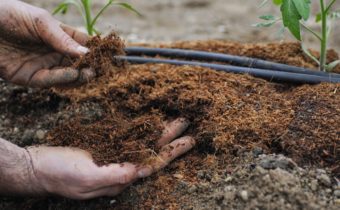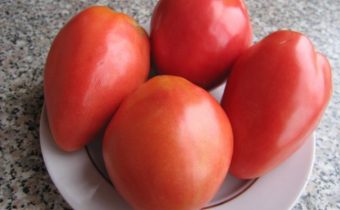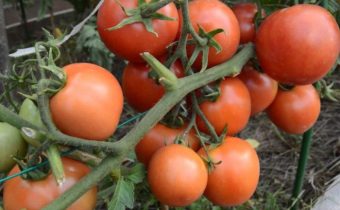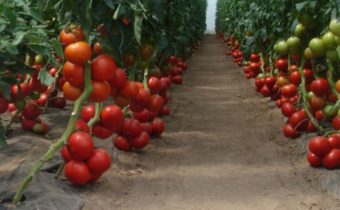Cooking compost for tomatoes
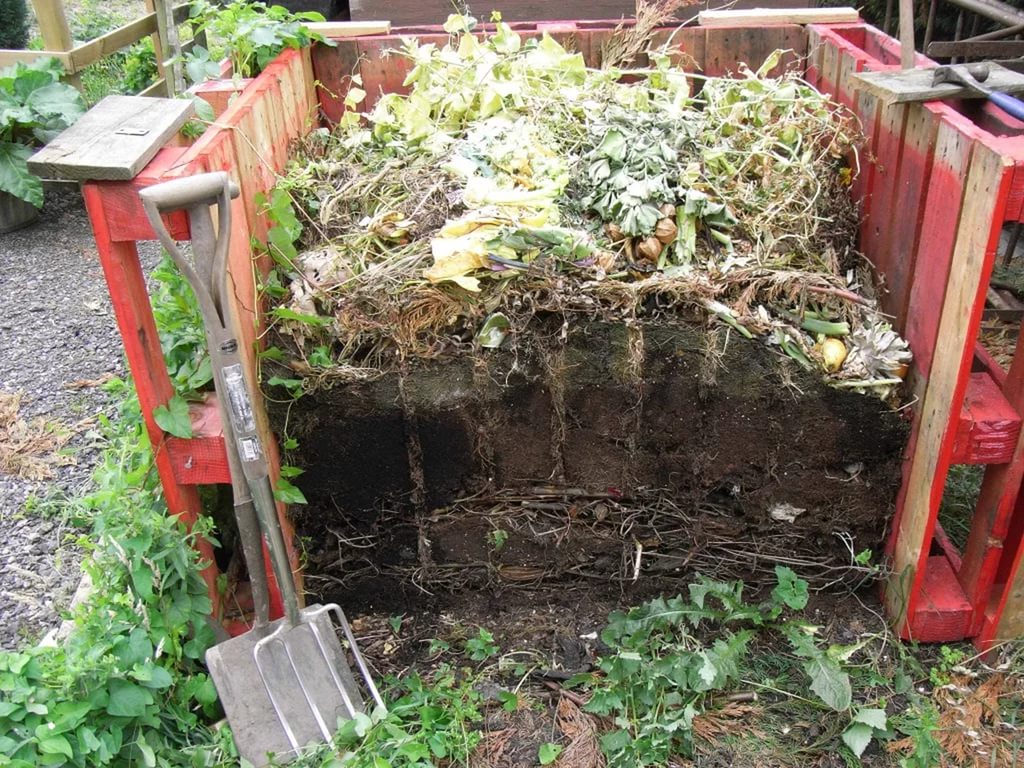
Compost is a natural and affordable fertilizer for vegetable crops. According to the content of nutrients it equates to humus. Organic dressing contribute to the garden or vegetable crops. It compensates for the lack of micro and macro elements, improves the structure of the soil.
Experienced agronomists recommend the use of fertilizer for the cultivation of tomatoes to get strong bushes and tasty, large fruits. Quality compost even in small doses doubles the yield. How to prepare such a fertilizer in your country?
Useful properties of compost
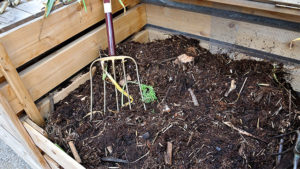
Compost - organic matter, decomposed as a result of vital activity of fungi, bacteria, worms and insects. The nutrient mixture is gradually saturated with phosphorus, potassium, nitrogen and other elements necessary for tomatoes. Natural heating of the compost substrate contributes to the death of pathogenic microorganisms and larvae of pests.
Compost has many advantages:
- Humus - a storehouse of nutrients that are easily absorbed by plants.
- Humus and soil form a homogeneous structure. Unlike mineral mixtures, it is not washed away by rain deep into the soil, but remains in the upper layers.
- The soil becomes loose, improves moisture permeability.
- Organic fertilizer consists of natural substances that do not cause excess. They do not accumulate in the ground, because undergo natural decay.
- Compost retains moisture well, so tomato beds can be watered less often.
- In clay soil enriched with humus, water does not stagnate.
- Microorganisms that inhabit organic fertilizer inhibit the growth of pathogenic bacteria.
The yield of vegetables is increasing not only in the current season, but also in the next year. Tomatoes grow strong, easier tolerate adverse environmental conditions.
Composting material
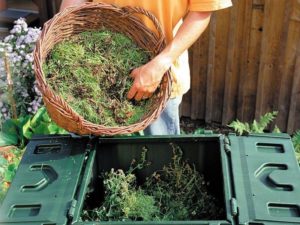
Compost not only increases the fertility of the soil, but also solves the problem of waste disposal. Organic material for the preparation of top dressing is conventionally divided into 2 groups:
- green, or nitrogen;
- brown - carbonaceous components.
The decomposition of green waste generates heat, accelerating the process of decay. Brown substances rot more slowly, without warming up. They provide friability of the substrate, retain moisture.
As nitrogen components suitable such waste:
- fresh cut grass;
- fruit tusk and vegetable waste;
- weeds that do not form seeds;
- vegetable garden haulm;
- food waste;
- green leaves, young shoots;
- seaweed;
- flowers;
- chicken droppings;
- rotted manure from farm animals.
Carbonaceous constituents include such material:
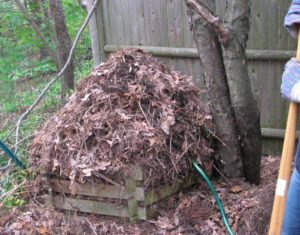
- dry leaves;
- shredded wood;
- sawdust;
- thin branches;
- hay, straw;
- needles in moderation;
- dry grass with roots;
- wood ash;
- paper without gloss, cardboard;
- corn stalk;
- eggshell.
No need to put in the compost such components:
- plants affected by diseases;
- garden waste containing poisons and pesticides;
- perennial weeds;
- poisonous plants: lily of the valley, henbane, buttercup ordinary, broom, etc .;
- fruit pits, grains, nuts;
- stems of tomatoes, potatoes and other plants susceptible to phytophthora;
- banana or orange peel;
- fats, dairy products;
- domestic animal feces, fresh manure;
- plastic, rubber, polyethylene and foam;
- wool, bones;
- coal ash;
- chemicals, disinfectants.
Do not add meat waste to the compost pile. When they decompose, a fetid odor appears that attracts flies and rodents.
Composting
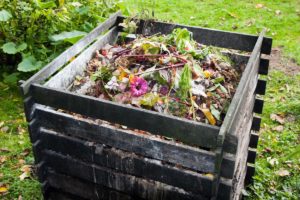
The process of turning greens, garden and household garbage into a useful feeding includes the following stages:
- active heating, reproduction of beneficial flora and earthworms;
- humus formation;
- mineralization of organic residues.
Choosing a place
Material for composting is put in a box or a hole with a depth of 0.5 m. Gardeners prefer a wooden structure without a bottom. It has the following advantages:
- good access of oxygen necessary for the vital activity of beneficial microorganisms;
- water does not stagnate;
- it is easier to shovel the compost and take out the ripened layer.
For the manufacture of the box is better to take the boards of pine, because they are more durable. Between them leave gaps for free air circulation. A thick film or slate is placed on top to prevent waterlogging and nutrient loss during rains. You can build a wooden cover. To make it easier to get humus from the bottom, the structure is equipped with a sliding section. The optimal size of the box is 1.5x1.5x1.0 m.
To the nutrient substrate is not dry, choose a shaded place. The bright rays of the sun only slow down the processes of decay. Nisin will not work, because there is always accumulated moisture, which causes souring of the lower fertilizer layer. The pile is placed in the far corner of the garden.
How to properly form a compost pile
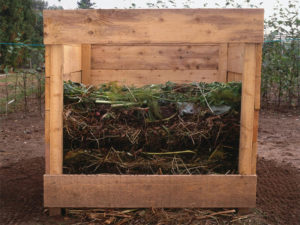
They lay a compost pile after the rain to keep the land moist. The process of its formation includes the following steps:
- The first layer consists of peat, chips, straw and small branches. Its thickness should be at least 10 cm. This layer performs the function of drainage.
- From above pour a layer of brown components in height of 15 cm. It is slightly condensed, then plentifully watered.
- Then a heap of 20 cm is supplemented with waste belonging to the green group of components.
- From above add a layer of the fertile earth 5-10 cm thick.
- Laying the material is repeated until the pile reaches a height of 1.5 m. Each layer is shed with separated water. When the compost has settled, you can add the following layers of waste and earth.
The material for the compost heap should be crushed as much as possible. And dry hay before laying is flavored with moist humus. Such measures will speed up the decomposition process.
The method of composting, in which organic substances rot slowly, is called cold. The contents of the heap are rarely mixed. Install a couple of boxes: one capacity is designed for storing waste throughout the summer and autumn, and the other - for the maturation of fertilizer.
To get a top dressing in 2-3 months, use the hot method: the ground between the layers is not poured, and the pile is covered with plastic wrap. The organic mixture needs to be shoveled frequently, watered with a solution of the catalyst. An excellent result is the use of Oksizin, intended for the processing of compost.
Composting Features
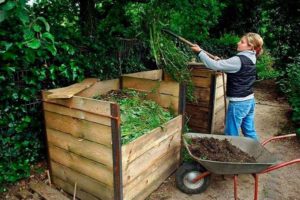
To prepare high-quality compost you need to follow these rules:
- Carbon and nitrogen waste should be mixed in equal proportions.
- The first time a bunch of shovel after 7 days. Experienced gardeners recommend mixing components 2 times a month, breaking up lumps. This procedure enriches the substrate with oxygen, accelerates the fermentation process.
- Nutrient substrate should be moistened regularly. In the summer heat it is watered more often. Water needs a lot to saturate all the layers.
- The ideal temperature for ripening organic fertilizer is + 55 ° C. In such conditions, the activity of microorganisms increases. With a thermometer reading of + 60 ... + 70 ° С, weed seeds and harmful bacteria are destroyed.If the heating of the substrate is insufficient, you need to add nitrogen components.
- To speed up the decomposition of organic matter, pour a bunch of infusion of manure or bird droppings. Biological products can be used: Baikal EM-1, Renaissance, Shine, Urgasa, Tamir or Ambiko Compost. Ripe fertilizer can be obtained in 2-3 months.
- For the winter, you need to fill up a pile with a thick layer of sawdust or dry leaves, and then cover it with plastic wrap.
The term of maturation of organic fertilizer is from 3 months to 2 years. The finished compost is dark brown in color, a crumbly homogeneous structure, with a characteristic earthy smell.
Gardeners mistakes
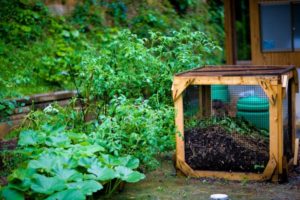
Beginning gardeners in the composting of organic waste make the following mistakes:
- Excessive compaction of components leads to impaired air circulation and stop the processes of decay.
- Having laid out only one "green" layer, having forgotten about "brown", it is possible to receive the stuck together substrate which is difficult for mixing.
- Before planting, the green parts of the plants should be held in the sun, so that they run down. Otherwise, they will create a dense layer that does not allow air to pass through.
- The water flowing out when the substrate is compressed is evidence of waterlogging. It is necessary to remove the covering material and shovel a bunch, adding hay.
- The appearance of ammonia smell indicates an excess of nitrogen components. You can correct the situation by adding carbon waste.
- The smell of rotten eggs appears when the components are compacted or the compost is rarely mixed. The reason - the lack of air. Waste need to shovel, after adding chips or shredded branches.
Composting
Compost is used for the following purposes:
- To fertilize the soil nutrient mixture is made during the digging of the land. It can be mixed into the soil, preparing the greenhouse for planting seedlings. The norm is 3-5 kg of humus per 1 m2.
- When planting tomatoes in the hole poured humus at the rate of 300-400 g per plant. It is mixed in advance with earth and sand.
- Organic improves the structure of sandy soil, which quickly loses moisture.
- Fertilizer is added to the clay soil to make it light and fertile.
- Compost is an excellent mulching material that prevents the growth of weeds and the drying of the upper layer of the earth.
- At humus pH is neutral. Regular application of this fertilizer helps to maintain optimum soil acidity.
- Organic dressing saturates the soil with beneficial microflora. Tomatoes grow healthy, less commonly affected by pests.
If you add manure to the heap with organic waste, the fertilizer will be ready for use no earlier than 2 years.
Compost is deservedly called "black gold". Its preparation demands the minimum expenses. Compliance with the technology allows to obtain high-quality fertilizer for garden crops. The correct composition of the compost restores the structure of the soil, increases its fertility. Using humus instead of chemical fertilizers, you can grow vegetables that are safe for health.


